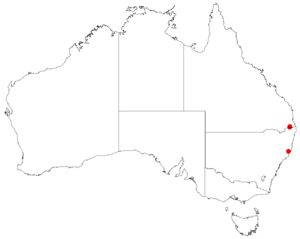Leptospermum barneyense facts for kids
Quick facts for kids Leptospermum barneyense |
|
|---|---|
| Scientific classification | |
| Genus: |
Leptospermum
|
| Species: |
barneyense
|
 |
|
| Where Leptospermum barneyense is found (data from AVH) | |
Leptospermum barneyense is a special kind of shrub that only grows in one place: the Mount Barney National Park in Queensland, Australia. This plant has rough, strong bark and its young branches have cool, noticeable ridges. Its leaves are shaped like spears, and it grows beautiful white or pink flowers. After the flowers, it produces round fruits.
Contents
What is Leptospermum barneyense like?
Leptospermum barneyense is a shrub that usually grows up to 2.5 m (8 ft 2 in) tall. It has rough, strong, grey bark on its main stem and branches.
Leaves and Branches
The young branches are smooth, which means they are glabrous. They also have clear, flat ridges called flanges. The leaves grow one after another along the stem. They are mostly attached directly to the stem without a stalk, which is called being sessile. Both sides of the leaves are the same color. They are shaped like a spear, about 17–23 mm (0.67–0.91 in) long and 2.5–5 mm (0.098–0.197 in) wide. The bottom side of the young leaves has tiny hairs near where they connect to the branch.
Flowers and Fruit
The flowers grow one by one where a leaf meets the stem. This spot is called a leaf axil. The flowers are also sessile, meaning they don't have a stalk. They are about 17–25 mm (0.67–0.98 in) wide.
The sepals are small, leaf-like parts that protect the flower bud. They are usually pink and smooth, about 3–4 mm (0.12–0.16 in) long. The petals are the colorful parts of the flower. They are white, but sometimes pink, and are shaped like an egg or are round. They measure about 5.5–8 mm (0.22–0.31 in) long. Inside the flower, the stamens are the parts that make pollen. They are about 2.5–3 mm (0.098–0.118 in) long.
This plant flowers from June to October. Its fruit is a thick-walled, smooth capsule. A capsule is a dry fruit that opens to release seeds. This fruit is also sessile and is about 5.5–8 mm (0.22–0.31 in) long and 8–11.5 mm (0.31–0.45 in) wide. It has a round base called a hypanthium.
How did it get its name?
Leptospermum barneyense was officially described for the first time in 2004. This was done by a scientist named Anthony Bean. He wrote about it in a science journal called Telopea. He used plant samples collected from the Mount Barney National Park to describe it.
The second part of its scientific name, barneyense, refers to the place where the first samples of the plant were found. This place is called the type location.
Where does it live?
This special leptospermum plant grows in areas with heath and low woodland. Heath is a type of open land with small shrubs. Low woodland is a forest with shorter trees. It can be found at high places, between 600–1,350 m (1,970–4,430 ft) above sea level.
Is it in danger?
The Queensland Government has listed Leptospermum barneyense as "vulnerable". This means it is at risk of becoming extinct in the future. This classification is under the Nature Conservation Act 1992, which is a law to protect nature.

